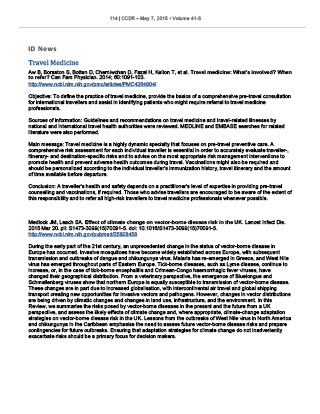ID News: May 2015

 Download this article as a PDF (342 KB - 1 page)
Download this article as a PDF (342 KB - 1 page) Published by: The Public Health Agency of Canada
Issue: Volume 41-5: Visiting friends and relatives
Date published: May 7, 2015
ISSN: 1481-8531
Submit a manuscript
About CCDR
Browse
Volume 41-5, May 7, 2015: Visiting friends and relatives
ID News
Travel Medicine
Aw B, Boraston S, Botten D, Cherniwchan D, Fazal H, Kelton T, et al. Travel medicine: What's involved? When to refer? Can Fam Physician. 2014; 60:1091-103.
Objective: To define the practice of travel medicine, provide the basics of a comprehensive pre-travel consultation for international travellers and assist in identifying patients who might require referral to travel medicine professionals.
Sources of information: Guidelines and recommendations on travel medicine and travel-related illnesses by national and international travel health authorities were reviewed. MEDLINE and EMBASE searches for related literature were also performed.
Main message: Travel medicine is a highly dynamic specialty that focuses on pre-travel preventive care. A comprehensive risk assessment for each individual traveller is essential in order to accurately evaluate traveller-, itinerary- and destination-specific risks and to advise on the most appropriate risk management interventions to promote health and prevent adverse health outcomes during travel. Vaccinations might also be required and should be personalized according to the individual traveller's immunization history, travel itinerary and the amount of time available before departure.
Conclusion: A traveller's health and safety depends on a practitioner's level of expertise in providing pre-travel counselling and vaccinations, if required. Those who advise travellers are encouraged to be aware of the extent of this responsibility and to refer all high-risk travellers to travel medicine professionals whenever possible.
Medlock JM, Leach SA. Effect of climate change on vector-borne disease risk in the UK. Lancet Infect Dis. 2015 Mar 20. pii: S1473-3099(15)70091-5. doi: 10.1016/S1473-3099(15)70091-5.
During the early part of the 21st century, an unprecedented change in the status of vector-borne disease in Europe has occurred. Invasive mosquitoes have become widely established across Europe, with subsequent transmission and outbreaks of dengue and chikungunya virus. Malaria has re-emerged in Greece, and West Nile virus has emerged throughout parts of Eastern Europe. Tick-borne diseases, such as Lyme disease, continue to increase, or, in the case of tick-borne encephalitis and Crimean-Congo haemorrhagic fever viruses, have changed their geographical distribution. From a veterinary perspective, the emergence of Bluetongue and Schmallenberg viruses show that northern Europe is equally susceptible to transmission of vector-borne disease. These changes are in part due to increased globalisation, with intercontinental air travel and global shipping transport creating new opportunities for invasive vectors and pathogens. However, changes in vector distributions are being driven by climatic changes and changes in land use, infrastructure, and the environment. In this Review, we summarise the risks posed by vector-borne diseases in the present and the future from a UK perspective, and assess the likely effects of climate change and, where appropriate, climate-change adaptation strategies on vector-borne disease risk in the UK. Lessons from the outbreaks of West Nile virus in North America and chikungunya in the Caribbean emphasise the need to assess future vector-borne disease risks and prepare contingencies for future outbreaks. Ensuring that adaptation strategies for climate change do not inadvertently exacerbate risks should be a primary focus for decision makers.
Page details
- Date modified: